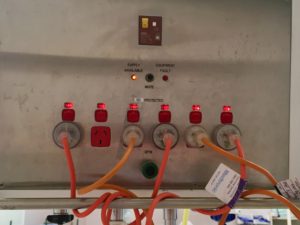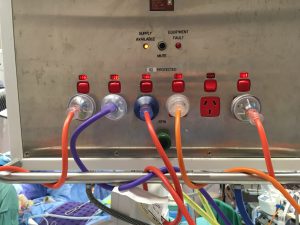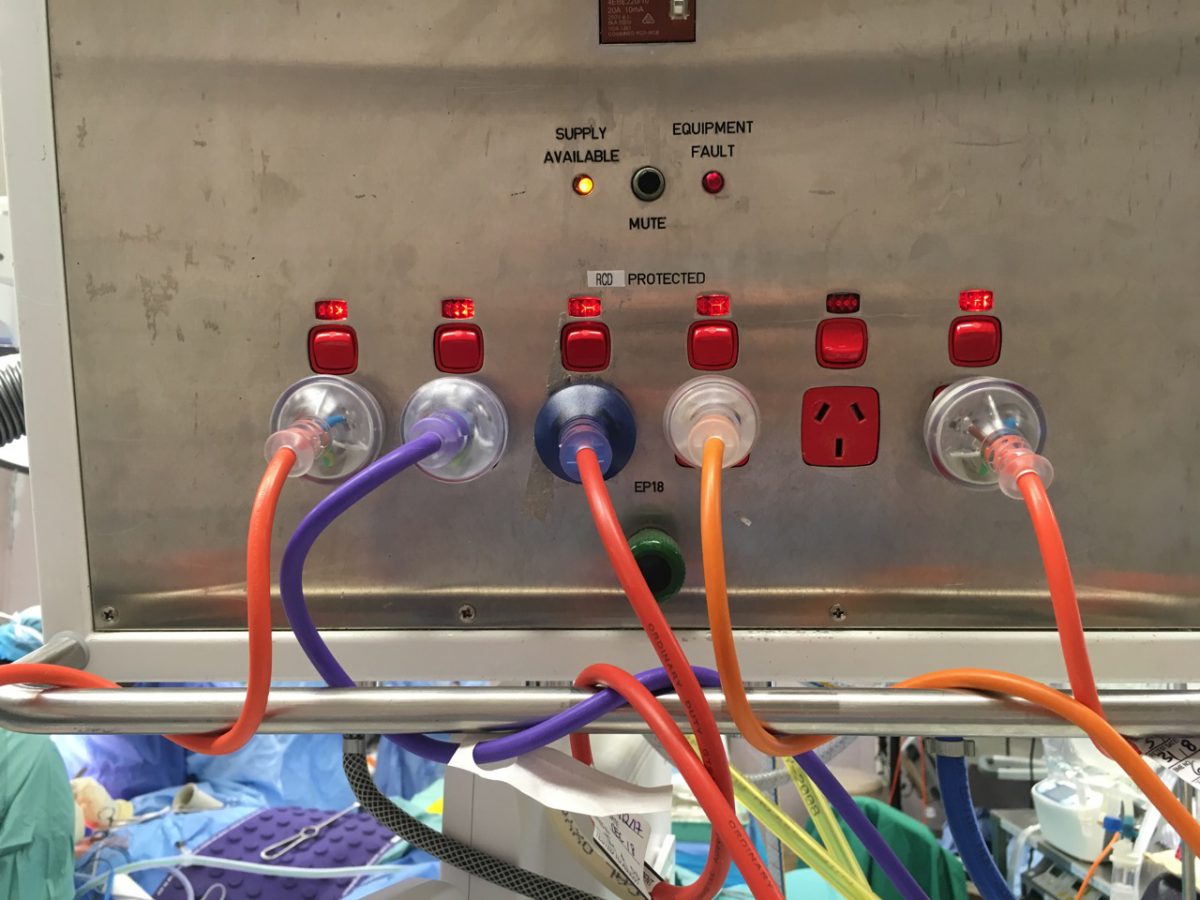Part of my job as an Anaesthesia Quality and Safety Fellow is to monitor reports made though our Anaesthesia Safety Monitoring Project, which allows staff to report latent safety threats, near-misses, faulty or badly designed equipment and pretty much anything that might pose a threat to patient safety. Below is the text of a “Letter to the Editor” that I wrote explaining how we were able to quickly and cheaply respond to an issue highlighted by one of these reports. The letter was published in the Canadian Journal of Anesthesia, and it can be accessed here (login required) or viewed online here by anyone.
To the Editor,
We would like to suggest a potential improvement to Dr. Pysyk’s idea of labelling the power cord of the anesthetic machine to warn against accidental disconnection. This letter was brought to our attention via a near-miss report made through our local anesthesia safety monitoring project. The anesthesiologist involved described ‘‘carefully trac[ing] the electrical cord of a theatre appliance back to the panel of outlets on the boom…[but] still manag[ing] to unplug the anesthetic machine.’’ Included in the report was a copy of Dr. Pysyk’s article1and the suggestion that we could implement a similar solution of power cord labelling.
Following discussions in both our local Human Factors and Equipment Committees, we implemented a variation on the labelling approach by changing the cords on our anesthetic machines from the orange colour shared by all our other equipment, to uniquely purple coloured cords.

 Figure 1: The first image above shows the original situation, where all operating room cords were orange and the anesthetic machine was inadvertently unplugged. The second image is after the anesthetic machine cord was changed to a purple one making it more distinguishable and less likely to be unintentionally disconnected.
Figure 1: The first image above shows the original situation, where all operating room cords were orange and the anesthetic machine was inadvertently unplugged. The second image is after the anesthetic machine cord was changed to a purple one making it more distinguishable and less likely to be unintentionally disconnected.
This has the advantage of identifying the cable along its entire course and from every viewing angle. Furthermore, it is not susceptible to fading or becoming detached in the same way a label is. It does, however, require the ability to distinguish between the orange and purple colours used, and this may be impaired by factors such as lighting conditions, use of protective eyewear (e.g., laser cases), or colour vision deficiency in staff.
A further safeguard to consider would be combining colour coding and labelling. Alternatively, the addition of a ‘‘lock-in forcing function’’ within the power cable attachment mechanism might also help prevent accidental disconnections, though an engineered solution such as that would be a much larger undertaking compared with the relatively inexpensive and simple solution that we implemented. The new cables cost $9.11 AUD each (ETD Pty Ltd, Chipping North, NSW, Australia) and replacement took approximately five minutes per machine (Aisys CS2 Carestation, GE Healthcare, Madison, WI, USA).
Our experience mirrors that of Dr. Pysyk in highlighting the importance of near-miss reporting systems, and the value of encouraging local responses to provide effective interventions for latent safety threats once they are identified.
We would also add that this risk from look-a-like power cords is increasing as the amount of electrical equipment used in theatres continues to increase. We suggest considering an international standard for labelling and colour coding of cables used to power critical equipment in hospitals to help reduce this risk. A starting point could be for anesthesiology professional bodies to include in their equipment standards that anesthetic machines be powered via purple electrical cords.
{4088554:TW54K7T4};{4088554:57BT7BV9}
nature
default
asc
no
1217
%7B%22status%22%3A%22success%22%2C%22updateneeded%22%3Afalse%2C%22instance%22%3A%22zotpress-d019baeec0f83ff99b18eb47491d13dd%22%2C%22meta%22%3A%7B%22request_last%22%3A0%2C%22request_next%22%3A0%2C%22used_cache%22%3Atrue%7D%2C%22data%22%3A%5B%7B%22key%22%3A%2257BT7BV9%22%2C%22library%22%3A%7B%22id%22%3A4088554%7D%2C%22meta%22%3A%7B%22creatorSummary%22%3A%22Scott%20Beattie%20et%20al.%22%2C%22parsedDate%22%3A%222018-07-01%22%2C%22numChildren%22%3A1%7D%2C%22bib%22%3A%22%3Cdiv%20class%3D%5C%22csl-bib-body%5C%22%20style%3D%5C%22line-height%3A%202%3B%20%5C%22%3E%5Cn%20%20%3Cdiv%20class%3D%5C%22csl-entry%5C%22%20style%3D%5C%22clear%3A%20left%3B%20%5C%22%3E%5Cn%20%20%20%20%3Cdiv%20class%3D%5C%22csl-left-margin%5C%22%20style%3D%5C%22float%3A%20left%3B%20padding-right%3A%200.5em%3B%20text-align%3A%20right%3B%20width%3A%201em%3B%5C%22%3E1.%3C%5C%2Fdiv%3E%3Cdiv%20class%3D%5C%22csl-right-inline%5C%22%20style%3D%5C%22margin%3A%200%20.4em%200%201.5em%3B%5C%22%3EScott%20Beattie%2C%20W.%2C%20Culwick%2C%20M.%20D.%20%26amp%3B%20Grocott%2C%20H.%20P.%20Canadian%20Anesthesia%20Incident%20Reporting%20System%20%28CAIRS%29%3A%20The%20Canadian%20Anesthesiologists%26%23x2019%3B%20Society%26%23x2019%3Bs%20National%20Patient%20Safety%20Initiative.%20%3Ci%3ECan%20J%20Anesth%5C%2FJ%20Can%20Anesth%3C%5C%2Fi%3E%20%3Cb%3E65%3C%5C%2Fb%3E%2C%20749%26%23x2013%3B756%20%282018%29.%3C%5C%2Fdiv%3E%5Cn%20%20%3C%5C%2Fdiv%3E%5Cn%3C%5C%2Fdiv%3E%22%2C%22data%22%3A%7B%22itemType%22%3A%22journalArticle%22%2C%22title%22%3A%22Canadian%20Anesthesia%20Incident%20Reporting%20System%20%28CAIRS%29%3A%20The%20Canadian%20Anesthesiologists%5Cu2019%20Society%5Cu2019s%20National%20Patient%20Safety%20Initiative%22%2C%22creators%22%3A%5B%7B%22creatorType%22%3A%22author%22%2C%22firstName%22%3A%22W.%22%2C%22lastName%22%3A%22Scott%20Beattie%22%7D%2C%7B%22creatorType%22%3A%22author%22%2C%22firstName%22%3A%22Martin%20D.%22%2C%22lastName%22%3A%22Culwick%22%7D%2C%7B%22creatorType%22%3A%22author%22%2C%22firstName%22%3A%22Hilary%20P.%22%2C%22lastName%22%3A%22Grocott%22%7D%5D%2C%22abstractNote%22%3A%22%22%2C%22date%22%3A%222018-07-01%22%2C%22language%22%3A%22en%22%2C%22DOI%22%3A%2210.1007%5C%2Fs12630-018-1141-z%22%2C%22ISSN%22%3A%221496-8975%22%2C%22url%22%3A%22https%3A%5C%2F%5C%2Fdoi.org%5C%2F10.1007%5C%2Fs12630-018-1141-z%22%2C%22collections%22%3A%5B%22JGDFB46T%22%5D%2C%22dateModified%22%3A%222018-11-22T00%3A51%3A55Z%22%7D%7D%2C%7B%22key%22%3A%22TW54K7T4%22%2C%22library%22%3A%7B%22id%22%3A4088554%7D%2C%22meta%22%3A%7B%22creatorSummary%22%3A%22Pysyk%22%2C%22parsedDate%22%3A%222017%22%2C%22numChildren%22%3A1%7D%2C%22bib%22%3A%22%3Cdiv%20class%3D%5C%22csl-bib-body%5C%22%20style%3D%5C%22line-height%3A%202%3B%20%5C%22%3E%5Cn%20%20%3Cdiv%20class%3D%5C%22csl-entry%5C%22%20style%3D%5C%22clear%3A%20left%3B%20%5C%22%3E%5Cn%20%20%20%20%3Cdiv%20class%3D%5C%22csl-left-margin%5C%22%20style%3D%5C%22float%3A%20left%3B%20padding-right%3A%200.5em%3B%20text-align%3A%20right%3B%20width%3A%201em%3B%5C%22%3E1.%3C%5C%2Fdiv%3E%3Cdiv%20class%3D%5C%22csl-right-inline%5C%22%20style%3D%5C%22margin%3A%200%20.4em%200%201.5em%3B%5C%22%3EPysyk%2C%20C.%20L.%20Risk%20of%20look-a-like%20equipment%20in%20anesthesiology%3A%20it%26%23x2019%3Bs%20not%20just%20medications.%20%3Ci%3ECanadian%20Journal%20of%20Anesthesia%5C%2FJournal%20canadien%20d%26%23x2019%3Banesth%26%23xE9%3Bsie%3C%5C%2Fi%3E%20%3Cb%3E64%3C%5C%2Fb%3E%2C%201291%26%23x2013%3B1292%20%282017%29.%3C%5C%2Fdiv%3E%5Cn%20%20%3C%5C%2Fdiv%3E%5Cn%3C%5C%2Fdiv%3E%22%2C%22data%22%3A%7B%22itemType%22%3A%22journalArticle%22%2C%22title%22%3A%22Risk%20of%20look-a-like%20equipment%20in%20anesthesiology%3A%20it%5Cu2019s%20not%20just%20medications%22%2C%22creators%22%3A%5B%7B%22creatorType%22%3A%22author%22%2C%22firstName%22%3A%22Christopher%20L.%22%2C%22lastName%22%3A%22Pysyk%22%7D%5D%2C%22abstractNote%22%3A%22%22%2C%22date%22%3A%2212%5C%2F2017%22%2C%22language%22%3A%22en%22%2C%22DOI%22%3A%2210.1007%5C%2Fs12630-017-0967-0%22%2C%22ISSN%22%3A%220832-610X%2C%201496-8975%22%2C%22url%22%3A%22http%3A%5C%2F%5C%2Flink.springer.com%5C%2F10.1007%5C%2Fs12630-017-0967-0%22%2C%22collections%22%3A%5B%22ICHFBI3J%22%2C%22CLL6ZQY5%22%2C%22MXVKNACE%22%5D%2C%22dateModified%22%3A%222018-11-20T22%3A28%3A12Z%22%7D%7D%5D%7D
1.
Scott Beattie, W., Culwick, M. D. & Grocott, H. P. Canadian Anesthesia Incident Reporting System (CAIRS): The Canadian Anesthesiologists’ Society’s National Patient Safety Initiative. Can J Anesth/J Can Anesth 65, 749–756 (2018).
1.
Pysyk, C. L. Risk of look-a-like equipment in anesthesiology: it’s not just medications. Canadian Journal of Anesthesia/Journal canadien d’anesthésie 64, 1291–1292 (2017).


 Figure 1: The first image above shows the original situation, where all operating room cords were orange and the anesthetic machine was inadvertently unplugged. The second image is after the anesthetic machine cord was changed to a purple one making it more distinguishable and less likely to be unintentionally disconnected.
Figure 1: The first image above shows the original situation, where all operating room cords were orange and the anesthetic machine was inadvertently unplugged. The second image is after the anesthetic machine cord was changed to a purple one making it more distinguishable and less likely to be unintentionally disconnected.

